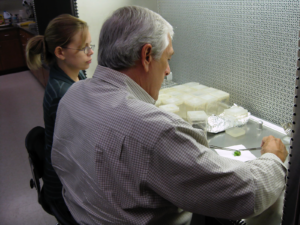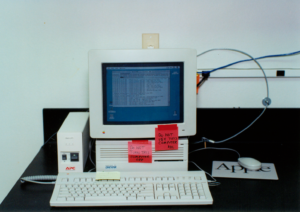World Wide Web more important now than ever to education
Texas A&M retiree leaves a legacy of internet use through Aggie Horticulture
After a year of pandemic-induced lifestyle changes, including online classes and virtual meetings, it is hard to imagine what life was like before so much information was at our fingertips.

There was a beginning to this expanded use of the internet for education, and at Texas A&M University much of it started with a faculty member who foresaw the need for information, literally, to be at the touch of a button.
Daniel Lineberger, Ph.D., recently retired head of the Department of Horticultural Sciences in Texas A&M’s College of Agriculture and Life Sciences, was at the forefront of web technologies being brought to the College, much of it through the use of the Aggie Horticulture website.
The Aggie Horticulture site allows users to access academic analyses and information on horticultural crops ranging from fruits and nuts to ornamentals and wine grapes. The information appeals to horticulturalists from beginners to well-seasoned experts.
Lineberger started his career with Texas A&M in 1990 as both the horticulture department head and a professor, after coming from Clemson University and The Ohio State University. His passion, he said, is plant micropropagation.
Teaching beyond the classroom
Lineberger found himself being pulled in a new direction, one that required innovation and problem-solving, as well as a lot of buy-in from those around him. In doing so, he jumped into the World Wide Web years before the idea was a popular one among others.
Lineberger jokes that it took the pandemic for some of his colleagues to finally get involved in online learning opportunities. He said getting faculty and other experts to buy in to this idea that the world was headed all online was one of his biggest challenges back in 1994, and the challenge continues even now.
After a time, others began to join in on his endeavor to make great use of the relatively new tool by sharing information related to horticulture and plant diagnostics, something a number of people were seeking on a regular basis.
“In ’94, I taught myself HTML and how to set up and operate a web server and got some colleagues in Extension excited about doing work on the web,” Lineberger said. “Then we got things kicked into gear. It was a culture shift, and it took the success of two or three of the people taking part to show the others that they really needed to get on board.”
New technology in the nick of time
In its time, the Aggie Horticulture project was designed to solve some very real problems the Texas A&M AgriLife Extension Service was experiencing. The agency was very rapidly losing its ability to mail out all the information people wanted, such as gardening information sheets. While the concept of providing that type of information through a computer system was not new, the web that was being developed made its actual distribution via computer possible.
“We realized we were going to be able to solve a really great need by doing that,” he said. “In a lot of ways, I was like the tool or the mechanic. It was all the other horticulturists who provided the information. I really enjoyed that part of learning how to use new computer systems, writing code, scanning and digitization.”
Lineberger and a team of student workers who he taught the basics of HTML began digitizing all the AgriLife Extension publications.
“It was really exciting at the time, and the students really liked being part of something new and different,” he said.
Lineberger and his team of student workers also began streaming videos, developing databases and giving users the ability to interact.
At the same time, he started developing what would become an approach to using websites and teaching for web-based instruction. This, in its infancy, was similar to the learning content management systems that we now see in many facets of education. But Lineberger built his own before they were widely available.
Not everything is online, though
While he was instrumental in giving the push to allow teaching and content to be available online, Lineberger will be the first to tell you he’s still a big proponent of in-person classes.

“I am still one who loves getting up in front of a group of kids and teaching, but I think this is something that provided a lot of answers for people who weren’t able to come to campus and a lot of situations where it was certainly appropriate,” he said.
From 2008-2012, Lineberger stepped into the role as associate head for undergraduate studies and during this time developed and advised the Texas A&M Horticulture Club.
“Working with the horticulture club was one of the most enjoyable things I ever did,” he said, adding the club is very active and usually the most outstanding in the southern region and at the national competition.
“We usually won at the national contest but always had some friendly rivalries there too,” he said. “That time was truly a great joy.”
The department’s future
Since Lineberger’s retirement, Patricia Klein, Ph.D., has stepped in as interim department head and continues much of the work started by Lineberger.
“He did a lot for the department and was so knowledgeable about horticulture from all aspects — landscape, molecular, breeding, viticulture, enology, all of it,” Klein said, “I personally felt like he was a mentor to me.”
Even now, serving as the interim department head, Klein said she has Lineberger on speed dial just to bounce around ideas and get his opinion on different matters.
With AgriLife Extension faculty and staff and because of what has happened with COVID, the need to connect to so many people online is more important now than ever. And Aggie Horticulture remains a place to house content that can continue to serve the public with new and updated information.
“We are doing so much more with Facebook Live and YouTube channels, and I think that will continue into the future,” Klein said. “Aggie Horticulture is so important to Texas and Texans, and really people all over the world use it to get information. I think it will only continue to grow.”
In the wake of winter storm Uri, many people have reached out about their trees and landscapes wondering if their plants survived and how to best assess and care for them.
“Our AgriLife Extension folks are already talking about the Green Aggies Chat,” Klein said. “They are talking about using Facebook Live so Texans can get this information immediately and will know what to do this spring when things start growing.”
Also in the department’s future is the continued growth of the viticulture and enology programs that Lineberger fostered, and a deeper dive into urban agriculture, Klein said.
And department research is focusing on nutrient-dense fruits and vegetables, greenhouses and vertical farming, hydroponics and aeroponics.
As those things develop, faculty will be building online resources for the public for the Aggie Horticulture site and Facebook Live discussion, as well as for chats and posting to YouTube, Klein explained.
“I certainly think that Aggie Horticulture will be a legacy of Dr. Lineberger’s, and people are going to be using it for years to come,” she said. “His are going to be some very difficult shoes to fill.”



